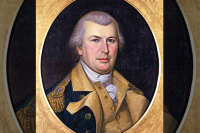Yaupon and the ‘Black Drink’
For some years now — when walking the woodlands around ancient Cherokee settlements — I have been on the lookout for an evergreen holly species that’s not native to Western North Carolina or the southern mountains. I haven’t yet encountered this particular holly and would very much appreciate hearing from anyone who has.
What I’ve been looking for is yaupon (Ilex vomitoria). This species of holly is common in coastal areas and uncommon in isolated spots in the piedmont. It is an evergreen, much-branched shrub or small tree that can be from six- to 20-feet tall with a diameter of about six inches. The elliptical, leathery, round-toothed leaves are about an inch and a half long. The red (rarely yellow) clusters of berries appear from September into November on female trees. As with other holly species, male and female flowers are borne on separate plants.
All of the Southeastern Indian tribes utilized the dried twigs and leaves of yaupon to make a brew thought to be a purifying agent. As the scientific name of the species indicates, one of the ways it “purified” was by inducing vomiting.
As early as 1573, the Spanish naval officer Pedro Menendez made peace with a group of Indians living where yaupon was not available by sending one of his men to them with an offering of the plant. They considered it to be “the greatest gift that can be made to them.”
Nancy J. Turner and Adam F. Szczawinski note in Common Poisonous Plants and Mushrooms of North America (Portland, Oregon: Timber Press, 1991) that “yaupon can be made into a mild tea, but if drunk in a concentrated brew can cause hallucinations and vomiting. It was used by southerners as a substitute for coffee and tea during the American Civil War.”
According to Charles Hudson’s account in The Southeastern Indians (Knoxville: University of Tennessee Press, 1976), the beverage was also thought to generally cleanse the soul, serve as a social bonding agent, and be the ultimate expression of hospitality.
Related Items
“In their own language, the Indians called the brew ‘white drink’ because white symbolizes purity, happiness, social harmony, and so on, but the Europeans called it ‘black drink’ because of its color,” observed Hudson. “To make black drink, the Indians first dried the leaves and twigs and put them in an earthen container and parched them over a fire to a dark-brown color. This roasting made the caffeine more soluble; coffee beans are roasted for the same reason. They placed the roasted leaves and twigs in water and boiled it until it was a dark-brown liquid. The drink then was poured through a strainer and into vessels to cool. As soon as it could be poured over one’s finger without scalding, it was ready to be consumed. Drinking it hot heightened its effect: caffeine is thirty times more soluble in boiling water than at room temperature ...The Indians sometimes used it as an emetic. On these occasions they would drink it in large quantities, and in a quarter to half an hour they would vomit. Sometimes they would hold their arms across their chests and expel the contents of their stomachs six or eight feet ... In any case, the emetic effect was more the exception than the rule. The Indians would often sit in council and drink black drink for hours at a time with no marked physical reactions.
“The physiological effects of black drink are mainly those of massive doses of caffeine (which) stimulates the central nervous system, exciting it at all levels. In fact, caffeine is the only true cortical stimulant known to modern medicine. It enables a person to have more rapid and clearer flow of thought, makes him capable of more sustained intellectual effort, and sharpens his reaction time. It also increases his capacity for muscular work and lessens fatigue. Moreover, some evidence suggests that large doses of caffeine speed up blood clotting .... These effects from large quantities of black drink could have been important and even decisive factors in activities such as the ball game (stickball) or warfare.
“But the Southeastern Indians drank black drink for ideological reasons as well as practical reasons. Meetings of the councils of chiefdoms were preceded both by drinking black drink and by smoking tobacco .... Two men came in through the door, each with a very large conch shell full of black drink. They walked with slow, measured steps and sang in a low voice. They stopped when they were within six or eight paces of the miko (chief) and members of the white clans sitting to his right, and they placed the conch shells on little tables. They then picked them up again and, bowing low, advanced toward the miko. The conch shell was then handed to the miko; the servants solemnly sang in sustained syllables, ‘Ya-ha-la,’ while the miko held the shell to his lips. After the miko was finished drinking, everybody else in the town house drank.”
Hudson also noted that Indian tribes in the interior portion of the continent where yaupon was not native “transplanted” the shrub “so that it would be close at hand.” Cherokee use of yaupon in “black drink” ceremonies has been well documented.
In his Travels Through North and South Carolina, Georgia, East and West Florida, the Cherokee Country, The extensive Territories of the Muscogulges or Creek Confederacy, and the Country of the Chactaws, first published in 1791, the Pennsylvania botanist William Bartram was the first non-Indian to note that the Cherokees cultivated the plant here in WNC and doubtless elsewhere within their mountain homeland.
In May of 1775, Bartram was traveling up the Little Tennessee River north of present-day Franklin. He laid over for two days at Cowe, a village situated at or near present-day Burningtown.
“Early in the morning,” Bartram recorded, “I set off attended by my worthy friend Mr. Gallahan, who obligingly accompanied me near fifteen miles, we passed through the Jore village, which is pleasingly situated in a little vale on the side of the mountain, a pretty rivulet or creek winds about through the vale, just under the village; here I observed a little vale of the Casine yaupon .... the Indians call it the beloved tree, and are very careful to keep them pruned and cultivated, they drink a very strong infusion of the leaves, buds, and tender branches of this plant, which is so celebrated, indeed venerated by the Creeks, and all the Southern maritime nations of Indians ....”
Frances Harper, in an annotated edition of Bartrams Travels (New Haven: Yale University Press, 1958) traced the botanist’s route through WNC and concluded that his “course lay up the valley of Iolta Creek. The ‘Jore village’ may have been ... on the divide between Iotla and Burningtown creeks .... The yaupon was here far inland from its natural range, and it must have been introduced by the Cherokees. It is very doubtful if it can have survived in that spot to the present day without the care of Indians.”
Well, maybe so — but then again, some fine day I might just locate a stand of yaupon naturalized somewhere in a sheltered spot up in the Big Cove community on the Qualla Boundary or in a far valley of the Nantahalas or Snowbirds. If so, it will mark the spot to which an ancient Cherokee medicine man had transplanted the plant for ceremonial use.
George Ellison wrote the biographical introductions for the reissues of two Appalachian classics: Horace Kephart’s Our Southern Highlanders and James Mooney’s History, Myths, and Sacred Formulas of the Cherokees. In June 2005, a selection of his Back Then columns was published by The History Press in Charleston as Mountain Passages: Natural and Cultural History of Western North Carolina and the Great Smoky Mountains. Readers can contact him at P.O. Box 1262, Bryson City, N.C., 28713, or at This email address is being protected from spambots. You need JavaScript enabled to view it..









